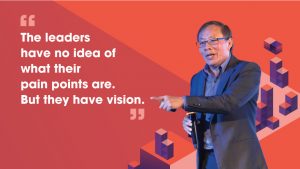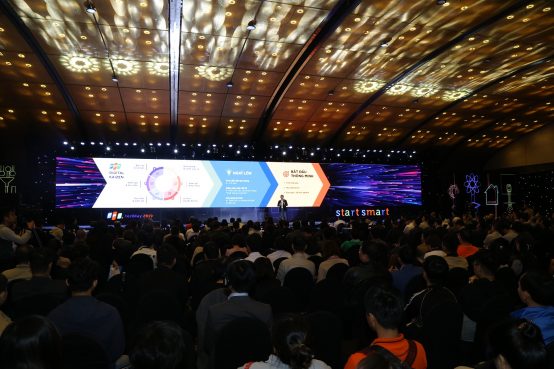Speaking at FPT Digital Transformation workshop, Dr. Phuong Tram emphasized, Digital Transformation is the inevitable journey of every business, but to make it exemplary will require the righteousness from the human and processes.
Analyzing the pain points that caused many companies around the world to fail to digital transformation, Dr. Phuong Tram also pointed out that: In order to transform successfully, firstly, it must solve the problems related to human resources by developing and training them; then solve customer related issues.
If an organization or company has not yet achieved a mature in its processes or technology, how to go Digital Transformation successfully?
Dr. Phuong Tram: Digital Transformation requires cross-function, a collaboration of multiple functions. Digital Transformation helps to solve problems differently. It should be understood that functions such as Sales, Finance will provide experts in their own expertise. Cross-function will bring out big results.
We shall not eliminate function units. Instead, we’ll promote cross-function. Once the solution is successfully implemented internally, we can advise and sell to customers. Creating documents, forming a platform is the work of the future. We can advise without platform because platforms are available. Know-how and the right solution is what matters.
In your opinion, how we should organize and structure to go Digital Transformation effectively?
Dr. Phuong Tram: Organizations may have multiple project levels but should establish Sponsor team with specific missions and strategies. Besides the Program Manager, Digital Lead, IT Lead, and Change Management Lead is required to work closely together. Once completed, it is the Change Management Lead who will document the processes and platforms.
Digital Transformation project staffs can allocate 80% effort for daily tasks and 20% effort for DT. Or, the staffs are completely focused on DT project. After finishing the project, they will return to the previous team to implement the project. Always remember that the project team members can come and go, can rotate, but the project must be reviewed every 3 months.
The important thing is, Digital Transformation is a day-by-day business and requires consistency.

Having worked for a long time with large consulting companies around the world. Can you share your opinion about the difference between FPT and other consulting companies such as Accenture and Deloitte to succeed in Digital Transformation?
Dr. Phuong Tram: Firstly, these companies have a source of money from ERP and they will not dare to destroy this source of money. Meanwhile, 90% of FPT’s profit is not coming from ERP and FPT is ready to challenge, ready to innovate.
The second thing, this is the 4.0 era. Think about Apple’s lesson, even though they were almost bankrupt at times, but with the ecosystem, the way they go, there’s no denying now that they have become one the world’s leading companies.
One of the things FPT owns but other companies don’t is FPT University, with young, good people, willing to learn, willing to try and be ready to challenge. We can break down FPT’s problem into small exercises, big assignments for students and take advantage of the idea from there. Students themselves are actually exposed to real problems, they will also gain experience and move faster to the real world. When you get the real problem, you get the real pain.
The last thing, their customers are not willing to pay too much for the unknown results. Digital Transformation is expensive, time-consuming and vague. We are investing in this strategy ourselves. Next time, when talking to customers, seeing customers’ problems, give them real solutions.
As you shared, Digital Transformation comes with defining pain point, so will this point be based on top-down will or function-based (bottom-up)?
Dr. Phuong Tram: Sponsor team is the unit that sets up projects. Cross-function is responsible for finding solutions. Then, the IT team or the new Digital Transformation team will use technology to implement the best solution.
In fact, the leaders don’t know pain points but they have a vision for the future. Therefore, the leaders will be the reviewers and approvers for the project. They also make sure that cross-function projects work effectively.
What are the criteria for selecting a project? The most important criterion is that the project must be consistent with the strategic vision of the company. The BODs must be the leaders of Digital Transformation because if they are not then who will?

So, according to you, after you have pain points, which pain points will you choose to solve firstly? Should Digital Transformation organization be at the company level or program level?
Dr. Phuong Tram: First of all, about pain point, the project must be consistent with the future strategy, vision, and mission of the organization. If it goes otherwise, something’s very wrong. Good projects for investment will include factors: value, ease of implementation and implementation time. If not bringing value, it is not worth doing. If it’s too hard to do, it’s not worth doing. If it takes a lot of time to do it, even if it is easy to do, it is not worth doing.
Secondly, in terms of size, organization, structure, what we often wrong the most is to follow consulting. Because consultants always try to make things bigger. The consultant knows that we are not ready to have the resource right away, then they will continue to “sell” people to us to take on these positions. And that is also a very easy way to consult. The organization of the Digital Transformation team should be organized in divisions instead of projects. This will avoid duplication. Besides, organizing this way, DT lead, IT Lead and Change Manager will get an overview of a wide range of projects related to DT.

To be Digital Transformation, don’t need to make a program that is too big, keep it small enough but decent. Bring all employees with high levels of engagement and then all employees in the process. 80% of the work is still daily tasks, but 20% will be Digital Transformation related work.
The staff has a high degree of cohesion, after participating in the Digital Transformation process will become “ambassador” when returning to your daily project. Further, they may become future leaders for DT. At that time, the staff became experts.
Just remember, big, complex structures are not as important as using human resource. How would you use them to lead, to manage, to develop individuals?
The good thing about consulting is that they use your own words, your own ideas and sell them back to you.
DX Future
dxfuture@fpt.com.vn



